Saint Rita of Cascia

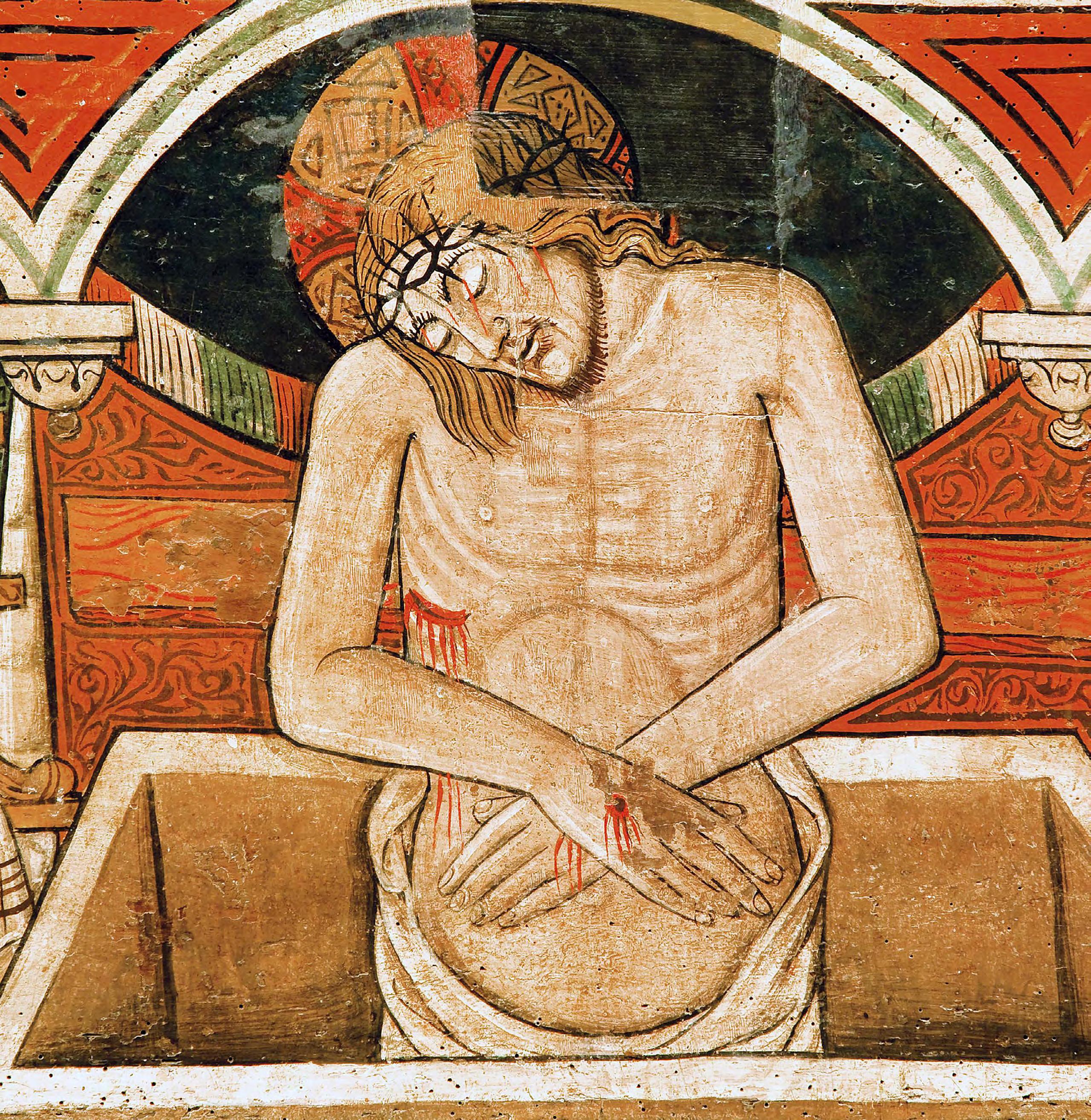
Spring 2024
On the first day of the week, Mary Magdalene came to Jesus’ tomb early in the morning, while it was still dark.
She came in sorrow, wishing to be close to the place where Jesus’ body lay, as people often want to hold onto some possession of a loved one for just a little longer. She came early so she could grieve in private, free of the noise or distraction of others. She came while it was still dark all around her, but dark also within due to her sorrow, for she did not yet understand that Jesus’ death was not the end of the story.
As she drew near, seeing that the stone had been removed from the entrance of the tomb, Mary’s sadness was mingled with alarm and distress, for she imagined that the body of her beloved friend had been stolen.
We may identify with Mary in that moment. We know what sorrow is. We’ve experienced loss in various ways and many times in life – the loss of a loved one through death or the loss of health, or position, or status, or selfrespect, or of a significant relationship. And perhaps we’ve come to know also how sorrow prolonged over time can lead to anxiety and distress.
At Mass we pray to God to keep us safe from all distress, “as we await the blessed hope and the coming of our Savior, Jesus Christ.” And we do that because we believe, as Mary would soon believe, that the Lord whom she mourned and whose body she imagined had been taken away was really alive and still with her. He had risen! What had been darkness for her became light; what was sorrow was turned into rejoicing. And that is the promise that holds true for us as well. The Resurrection that we celebrate at Easter, and always, is not one among many events that we recall from the life of Jesus. Through Jesus, it is the wellspring that enlivens and renews each one of us continually and forms us into his People, the Church.
Sometimes, our experience of the Good Fridays of life can be long and very difficult. The disappointment and distress of the Holy Saturdays we come to know can leave us waiting in stillness and emptiness for what may seem an eternity. But we are not defined by the Good Fridays or the Holy Saturdays of life. “We are an Easter People,” Saint Augustine exclaims, “and our song is Alleluia!” This is no mere wishful thinking. It is not some easy game of “let’s pretend” so that we can get by in life. It is, rather, God’s great gift to us that fulfills Jesus’ own promise: “I have come that you might have life, and have it to the full.”


“We are an Easter people, and our song is Alleluia.”
Saint Augustine

H e I s R I sen , Alleluia!

LOVE
always leaves a mark

Prayer to Saint Rita
O powerful Saint Rita, I come to you with confidence in my great need. You know well my trials, for you yourself were many times burdened in this life. Come to my help, speak for me, pray with me, intercede on my behalf before the Father. I know that God has a most generous heart and that he is a most loving Father. Join your prayers to mine and obtain for me the grace I desire,
(here mention your request)
I promise to use this favor when granted, to better my life, to proclaim God’s mercy, and to make you more widely known and loved. Amen.
One day, the story goes, the devil appeared to Saint Theresa of Avila disguised as the Risen Christ. Immediately seeing that she was being tricked, she sent him away, and as he left, he asked, ‘How did you know that I wasn’t your Christ?” and she answered, “Because you have no wounds.”
Love always leaves a mark, and the love with which Jesus accepted the cross signed him forever with the wounds that even his rising did not take away. When Jesus appeared to the apostle Thomas some days after the resurrection, he invited Thomas to touch those wounds, not only as confirmation of his identity, but as a compelling reminder of what love had empowered Jesus to endure.
Saint Rita carried a mark of love on her forehead for fifteen years. She had received it in professing her love for Jesus one Good Friday afternoon as she was contemplating his suffering and death. It truly was a mark of love, occasioned by the declaration of her love for him but bestowed as a gift in his grateful love for her.
Saint Rita of Cascia in Penance by Jose Luis Castrillo
Saint Rita of Cascia
Spring 2024
Mission
Founded in 1907 by the Augustinian Province of Saint Thomas of Villanova, the National Shrine of Saint Rita of Cascia is a Roman Catholic community of prayer and worship deeply rooted in Augustinian spirituality. Inspired by the life of Saint Rita of Cascia, an Augustinian saint known as a healer, reconciler, and peacemaker, the Shrine seeks to inspire people from all walks of life to live these virtues as they come to know and encounter God and others.
Cover: Jesus of Holy Saturday Cascia, Italy
Contributors to this issue are:
Jonathan Jerome
Paul Koenig
Fr. Michael Di Gregorio, O.S.A.
Design: accent communications, inc.
We Love to Hear from You
Your comments and questions, your stories of favors received, or experiences related to Saint Rita, are most welcome. Email: editor@SaintRitaShrine.org.

Saint Rita’s Popular Devotion
The National Shrine of Saint Rita of Cascia was founded by the Augustinian Friars of the Province of St. Thomas of Villanova in 1907 and continues to be served by them under Executive Director Jonathan Jerome.
1166 South Broad Street
Philadelphia, PA 19146 215-546-8333
SaintRitaShrine.org
© copyright 2024
The image you see on the front cover of the magazine bears the title Jesus of Holy Saturday. It portrays our Lord in the moment of his resurrection from the tomb and was a popular devotion in both the spiritual life and the religious-cultural experience of Saint Rita. So fond was she of this devotion, that at her death it was decided to place this image on the front panel of Rita’s coffin together with her own portrait and that of Saint Mary Magdalene, patroness of Rita’s monastery. It is believed that Rita received on her forehead the wound caused by a thorn from Jesus’ crown while praying before this image of the rising Jesus one Good Friday afternoon.
For this reason, in the renovation of the lower Shrine undertaken several years ago, we chose to include a rendering of this devotion – which you see above – to recall our saint’s devotion. The wound was a sharing in the passion of Jesus and a sign of Rita’s willing desire to take up the cross and follow Jesus.
Jesus of Holy Saturday by Anthony Visco, Lower Shrine

A house of prayer, Saint Rita messenger of and oasis for the restless
By Paul Koenig, Coordinator of Programs and Pilgrimages
DPaul Koenig is a 2018 graduate of Saint Joseph’s Prep in North Philadelphia and the holder of a Bachelor of Arts degree in political science and economics from Saint Joseph’s University. Following graduation in May 2022, Paul joined Pricewaterhouse Coopers. In September 2023, he joined the staff of Saint Rita Shrine, bringing with him a rich college experience with SJU’s Campus Ministry initiatives, retreats, and service programs in Philadelphia and El Salvador.
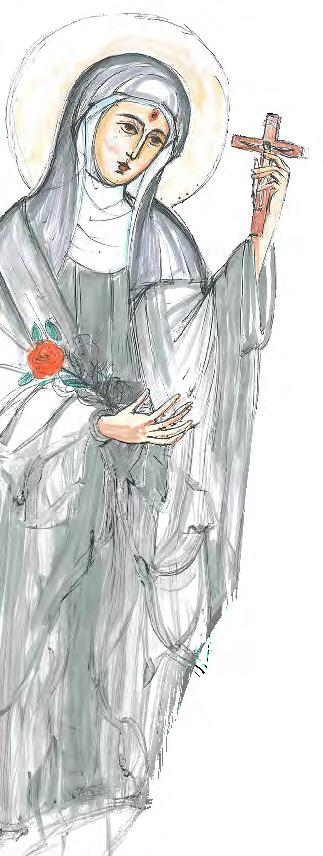




Sixteen yearly Shrine programs modeled on Saint Rita’s vocations, highlighting: youth ministry work of women counseling for families and bereaved issues of peace and justice
uring my first three months at the National Shrine of Saint Rita of Cascia, I have had unique and formative opportunities to experience programs and pilgrimages as both a leader and participant. As the Shrine’s first coordinator of programs and pilgrimages, I have been privileged to welcome and lead groups from throughout the country as they visit South Philadelphia to learn about the life of Saint Rita and pray for God’s grace through her intercession. Among these initial groups have been 250 Haitian Americans from across New York, Massachusetts, and Connecticut; hundreds of young men and women from area high schools and grade schools; Augustinian Friars in formation; boys and girls preparing for First Reconciliation or Confirmation; 35 college students from Augustinian universities; and faculty and administrators from Catholic educational institutions. In welcoming these groups, I have seen the universal and meaningful impact that the Shrine – as a house of prayer, a messenger of Saint Rita’s story, and an oasis for the restless – has on visitors during the course of a retreat, day of service, or tour.
As a recent pilgrim myself to the Shrine of Santa Rita in Cascia, Italy, I witnessed the influence that Rita has on people while touring the basilica and attending Mass with thousands of devotees from across the world. As participants in the Second International Conference for Rectors and Pastoral Personnel of Shrines at the Vatican in November 2023, Fr. Bob Guessetto, O.S.A., and I heard from Pope Francis a simple yet important message to all Shrines: “One comes to the Shrine, above all, to pray…. One goes to Shrines also to be consoled…. Finally, one goes to the Shrine to look to the future with greater confidence.” Having seen firsthand the continuing impact of Saint Rita on modern-day pilgrims and having heard the Holy Father share his vision for Shrines in today’s world, I find myself wrestling with a question: “What is the purpose and role of the National Shrine of Saint Rita of Cascia in 2024 and
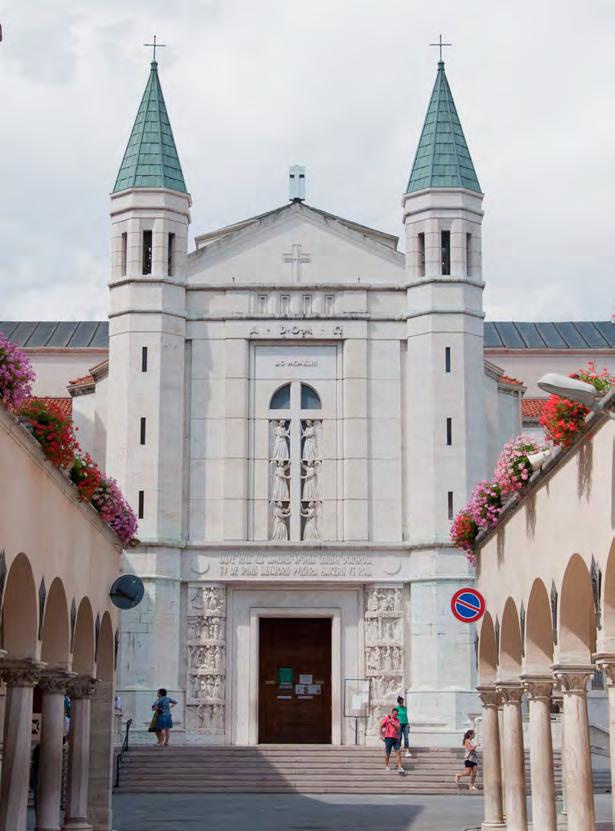 Shrine of Santa Rita Cascia, Italy
Pope Francis with Paul Koenig
© Vatican Media
Shrine of Santa Rita Cascia, Italy
Pope Francis with Paul Koenig
© Vatican Media

beyond?” And my answer is twofold. First, we must continue to serve as a spiritual home for all people by offering radical hospitality to pilgrims as they join us for Mass, Confession, retreats, tours, and days of service. As the Pope noted, people come to the Shrine to pray, to seek consolation, and to find hope. Because Rita is a saint for all people, her virtuous life serves as a guide and model for us all! Therefore, our Shrine must share the story and message of Rita’s life without hesitation. In doing so, we offer pilgrims not only space to pray, to be consoled, and to find hope, but a companion – Rita –who helps them know and love God more deeply.
We must continue to serve as a spiritual home for all people.
embodies the Shrine’s role as an ambassador of Rita’s life. By offering 16 programs each year that are modeled on her different vocations, we aim to engage long-connected patrons and new friends from the wider community in an intentional, exciting way. By reimagining our programs to highlight youth ministry, the work of women, counseling for families and bereaved, and issues of peace and justice, we not only allow patrons to draw near to God through Saint Rita’s life, but we also draw near to those who may not know Rita yet.
Our second purpose is intimately tied to the first. We must continue to offer robust programming on a national, regional, and local level that

This twofold approach allows us to answer Pope Francis’ call for Shrines in the modern era and follow the example of Saint Rita of Cascia more closely. How exciting as we continue the Shrine’s 117-year tradition as a house of prayer, a place of consolation, and a beacon of hope for all!


Vatican Shrine conference
In fall 2023, Father Bob Guessetto, O.S.A., assistant Shrine director and Mr. Paul Koenig, Coordinator of Shrine programs and pilgrimages, participated in the Second International Conference for Rectors and Pastoral Personnel of Shrines held in Vatican City. The conference was sponsored by the Vatican Dicastery for Evangelization and had as its theme The Shrine: A House of Prayer. The 2023 conference was held in view of both the preparatory Year of Prayer of 2024 and the Holy Year of 2025. Mr. Koenig, who was chosen to lector at one of the Masses of the conference, also had the opportunity to greet Pope Francis and to present him with the gift of a specially designed Saint Rita candle on behalf of the Shrine.
Saint Hubert Catholic High School at the Shrine for a retreat
Fr. Bob Guessetto, O.S.A. and Paul Koenig
The conversion of
Saint Augustine
Within the Easter season this year, we celebrate the Feast of the Conversion of Saint Augustine on Wednesday, April 24. This is a feast of great importance not only for Augustinians, but for the universal Church, given the extraordinary influence this one man’s acceptance of Jesus so many centuries ago has had – and continues to have – on all of Christendom, as well as on humanity in general. Certainly the individual stories of very many people since have been shaped and guided in large part by Augustine’s decision to embrace, proclaim, and follow Christ and his Gospel so whole-heartedly. One such person was Rita Lotti Mancini, who, as a young girl, chose him as one of her special patrons and later, as a young widow, embraced the monastic way of life he had founded, the essential character of which is nothing other than to love God and neighbor in a shared common life, wherein all are intent upon God in oneness of mind and heart.

 Saint Augustine by Wladimir Petrichev
Saint Augustine by Wladimir Petrichev
A
Parent’s Prayer Saint Rita to


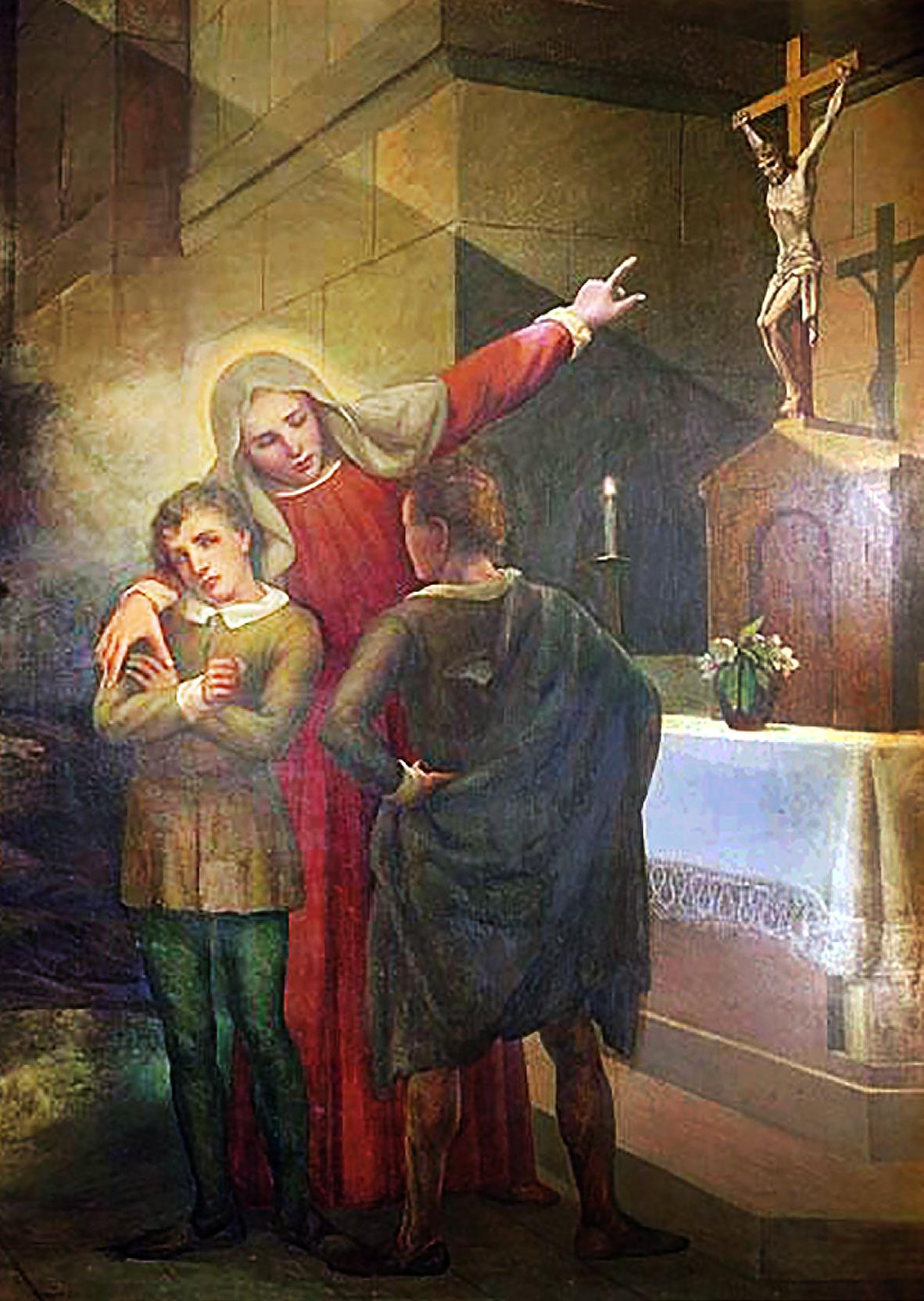
Good Saint Rita, God blessed your marriage with two children whom you loved with great affection and reared in his holy ways. Pray that I may help my children to know and love God. Help me to be a truly Christian parent to them in word and action, to give them good example, and to inspire them to embrace the Gospel. Pray with me that they may always remain close to the Church, conscious of God’s presence, and faithful to their responsibilities. Preserve them from all evil and help them to be steadfast in faith, joyful in hope, and enduring in love. Amen.
 by S. G. Rudl,
by S. G. Rudl,
Follow Me
One day, following the events of his death and resurrection, Jesus came upon the apostles as they were out fishing. They had not been doing a very good job of it, but Jesus helped them out. After an abundant catch of fish, they shared breakfast with him. Eventually, Jesus and Simon Peter went off by themselves and Jesus asked Peter about his love for him. Jesus told Peter to feed his sheep and predicted the way in which Peter would later meet his death, precisely out of love. His word to Peter was simple and direct: “follow me.” At that moment, Peter noticed that another apostle was nearby, the one called “the beloved disciple.” “What about him?” Peter wanted to know. “Never mind about him,” Jesus said in so many words. “Your business is to follow me.”
Our business is no different from that of Peter: to follow Jesus. The Gospel that Jesus preached tells us how to do that, indicating principles that mark out the path of Christian discipleship for us. But principles and norms can too easily remain abstract and hypothetical.
What are also needed are strategies and tactics. We need a plan that takes all these and applies them to everyday life. In religious terms, we need a spirituality; that is, a path that presents a method
for translating the teachings of Jesus into action.
The story of Saint Rita reveals elements that provide insight into the person she was and the values that defined her. The events that marked her life and the circumstances that impacted her journey shed light on what distinguishes her and the message she proclaims From these we can draw five aspects of Rita’s character and spirituality that can be valuable for Christians today.
Jesus and Apostles fishing
Prague
fiVe LeSSonS from Saint Rita to foLLow Jesus today
1. Ability to listen
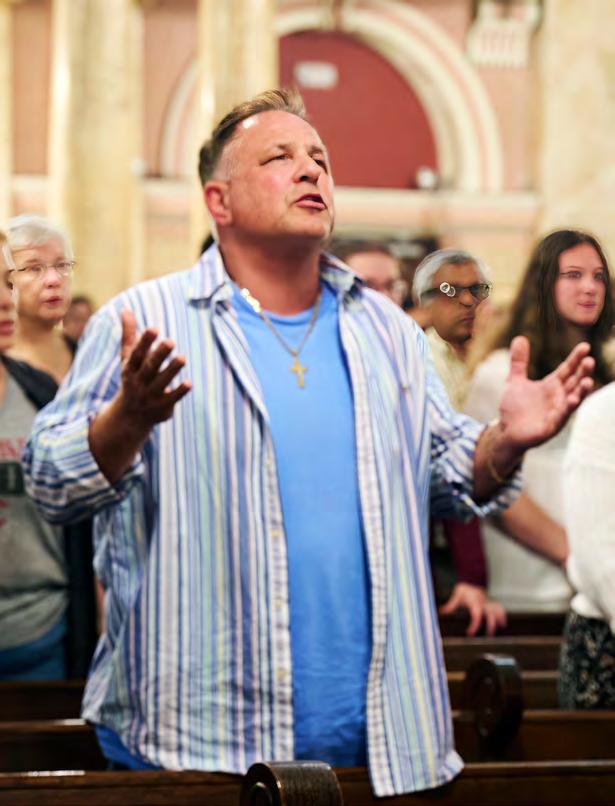
Rita was always receptive to the opinion of others in coming to discern God’s will. As a young girl, she listened attentively to the concern of her parents for her security within a good marriage, even though she was strongly attracted to religious life. Rita came to view their judgement as God’s plan for her, and she accepted it willingly. But she was not simply docile and submissive to the opinion of others. Later, after the tragic loss of her husband and sons, she did not accept the decision of the nuns who denied three times her entry into the convent. Rather, she held firmly to the conviction that God wanted her there. Discernment invites us to be attentive but not passive or acquiescent.
2. Willingness to forgive
Among the most striking elements of Rita’s story is the extraordinary example of forgiveness she displayed in response to the murder

of her husband and the consistent message of mercy that she proclaimed to her children. From her earliest years she had learned the lesson of forgiveness from her parents and witnessed the very practical way in which they offered themselves as instruments of this gift among their fellow townsfolk, working to bring reconciliation to those who had become estranged. As they believed, so did Rita, that the message of forgiveness is at the heart of Jesus’ mission and, therefore, of each of his disciples’ as well.
3. Courage to heal
The first movement of Rita’s imitation of Jesus in extending pardon for the loss she had suffered was significant and, no doubt, costly. But in forgiving she found freedom. Later, she came to understand that something else was being asked of her – namely, to bring healing to those estranged still by the same enmity that had caused her suffering. The natural conclusion of her personal act of forgiveness was to be a shared experience of reconciliation. And Rita herself was to be its agent, just as her parents had been so many times before. Sometimes forgiveness – difficult as it may be – invites us to something more: the healing that reconciliation brings.
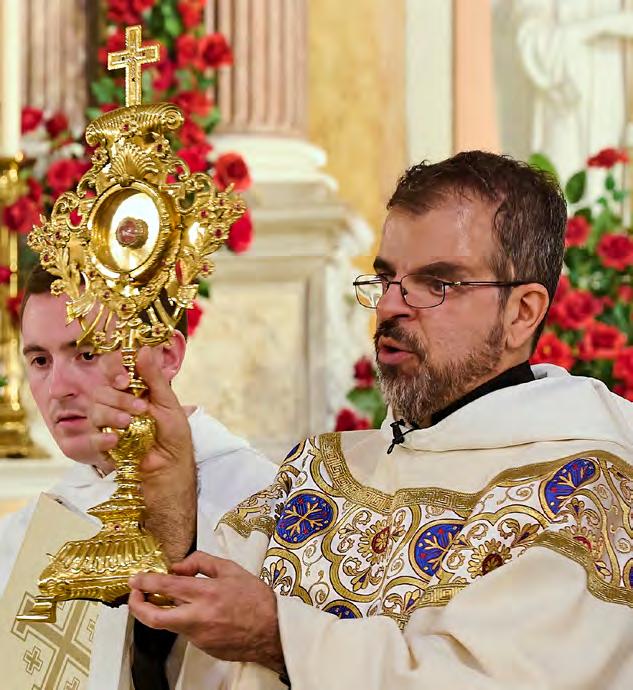
- continued on next page
4. Appreciation of silence

We may not be surprised by the fact that the 40 years of Rita’s life in the convent were marked by a significant commitment to recollection in an atmosphere of silent reflection and prayerful engagement. However, it would be inaccurate to think that the earlier years of her life as a young girl, a wife, and a mother were, by contrast, devoid of any cultivation of the interior life.
Certainly, her many visits to the mountain peak of Roccaporena as a young girl and later as a widow were made precisely for the purpose of prayer and discernment. as her story informs us. Nurturing the contemplative side of life was not the exclusive concern of her convent years. It was a dimension of her vocation as a Christian all along her life’s journey, as it is also for us.
HOW to FOLLOW JESUS
5. Decision to love

At the heart of the Gospel message is the invitation to love even as we are loved. St. John reminds us that “God loved us first,” and so made us capable of loving him in return, and loving others after his own example. Only such love, in imitation of the divine gift and invitation, makes the lives of saints like Rita intelligible: giving oneself totally and unconditionally to the works by which generosity, hospitality, forgiveness and even acceptance of hardship – which we Christians call ‘carrying the cross’ – become life-giving. The decision to be loving in all situations, irrespective of persons, circumstances and cost, is the ultimate expression of self-giving, and thus the clearest proof of discipleship to Christ, to which all of us have been called, and by which Rita’s attraction draws and encourages us.
Like a DISCIPLE at
the SHRINE:
LISTEN: Sign up for Spiritual Direction. What better way to discern God’s will in your life than by having one of our Augustinians or lay staff accompany you on your spiritual journey!
FORGIVE: Offer a prayer for the person you find most difficult to forgive. Whether it is written on your heart, or submitted to the Shrine, prayer is a great way to begin the process of forgiveness.
HEAL: Make the Sacrament of Reconciliation a part of your monthly routine. We offer it twice a day (10:45 a.m. and 4:00 p.m.), Monday through Saturday in the Lower Shrine.
SILENCE: Spend time in Adoration of the Blessed Sacrament. Sitting in silence before the Holy Eucharist will help to cultivate your own interior life as you deepen your relationship with God.
LOVE: Visit the Shrine’s Gift Shop (SaintRitaShrine.org/gift-shop) to purchase a devotional item. When you make your purchase, consider buying a second item to be given as a gift.



Remembering Our Forebears
 AFr. Matthew John Corcoran, O.S.A.
AFr. Matthew John Corcoran, O.S.A.
mong the many significant contributors to the devotion to Saint Rita at the National Shrine is Father Matthew John Corcoran, O.S.A. He was born in Philadelphia on July 23, 1886, and baptized in our nearby Church of St. Augustine. After attending public schools, he entered the Augustinian novitiate at Villanova in 1904, and professed vows on July 4, 1905. In September 1906, he sailed for Rome to continue his studies, and he made solemn profession of vows in 1908. He was ordained to the priesthood in Rome on July 4, 1909.

Father Corcoran was assigned to Saint Rita’s Church shortly after his return home, but in December 1910 he was transferred to Villanova, where, several months later, he was appointed vice president of Villanova College and several years later was named subprior of the Villanova Monastery. He later returned to Saint Rita, where he spent 17 of his 21 years as a priest. While serving here as prior and pastor, he was also frequently called upon to preach parish missions. He was an enthusiastic promoter of devotion to Saint Rita as well as vocations to our Order. He wrote a popular biography known as “Our Own Saint Rita.”
During his pastorate, Father Corcoran introduced the “Three Hours Agony” devotion, and 1924, he revived and edited the Augustinian Good Counsel magazine. Father Corcoran was only 44 when he died on June 20, 1930, while undergoing surgery for cancer, after a six-month illness. He is buried in the Community Cemetery at Villanova.
Secret Favor MARY’S
Mary F. from Maryland called the Shrine recently to tell us about a favor she received 17 years ago, but which she is able to make public only now. When her grandson was 20 months old, he could not walk and was going to therapy.
Mary’s daughter-in-law, the boy’s mother, was not Catholic and was not well disposed to her husband’s parents. One day when Mary was alone with her grandson, she anointed the boy’s legs with Saint Rita Oil and prayed for Saint Rita’s intercession with God that her grandson might be healed. Immediately after this prayer, she sensed that her prayer had, indeed, been answered.
Three days later, her son called to say that the boy stood up by himself and walked around the house. Six days after the anointing, the boy walked alone up a hill behind their home. Mary never told anyone about the anointing except her husband and her priest for fear that her daughter-in-law might be upset by the fact and prevent her from seeing her grandchildren. She has told us the story now because her grandchildren are all grown and, unfortunately, the marriage recently was dissolved.
 Saint Rita, 1910
Saint Rita, 1910
The Cascia Center
Ministries of Healing, Support, and Transformation
Pastoral Counseling and Psychotherapy
Marriage and Couples Counseling
Spiritual Direction
Men’s Group: weekly support and spirituality to address pornography use and sexual addiction and promote chaste living
Ministries of Education and Renewal
Student and Teacher Retreats, Pilgrimages, and Conferences
Parish Staff Retreat Days
Days of Recollection for Caregivers and Ministers
Consultation, Support, and Supervision for Clergy and Ministers
Education in Conflict Resolution, Reconciliation, and Forgiveness
Sacramental Ministries
Novena of Reconciliation Masses
Novena of Healing Masses
Evenings of Reconciliation, Adoration, and Witness
Daily Sacrament of Reconciliation

In every ministry of healing, support, transformation, education, renewal, and welcome, the Cascia Center is a place where these types of stories are honored and shared as sacred gifts for our mutual benefit and healing.
For several years, following the completion of the lower Shrine’s renovation, our great desire had been to construct a pilgrim center adjoining the church to provide hospitality to Shrine patrons and guests. After a number of plans had been suggested but found difficult to implement or beyond the Shrine’s resources, the Augustinians entered into an agreement with the Archdiocese of Philadelphia by which a mixed-use facility was able to be constructed. The new structure, known as Saint Rita Place, provides a multipurpose center on the ground floor for the use of the Shrine, as well as 48 low-income
housing units on the upper four floors for senior residents. The building was dedicated in November 2021, and the Cascia Center, the area dedicated to use of the Shrine, was occupied soon after. The center features a large banquet room with adjoining kitchen that serves also as a gathering space for pilgrim visitors, meetings, and lectures, in addition to a second hall for smaller meetings, several offices for staff members and a large vestibule area.

PRAYER PLANNING DIALOGUE FRIENDSHIP
Mother Our Good of Counsel
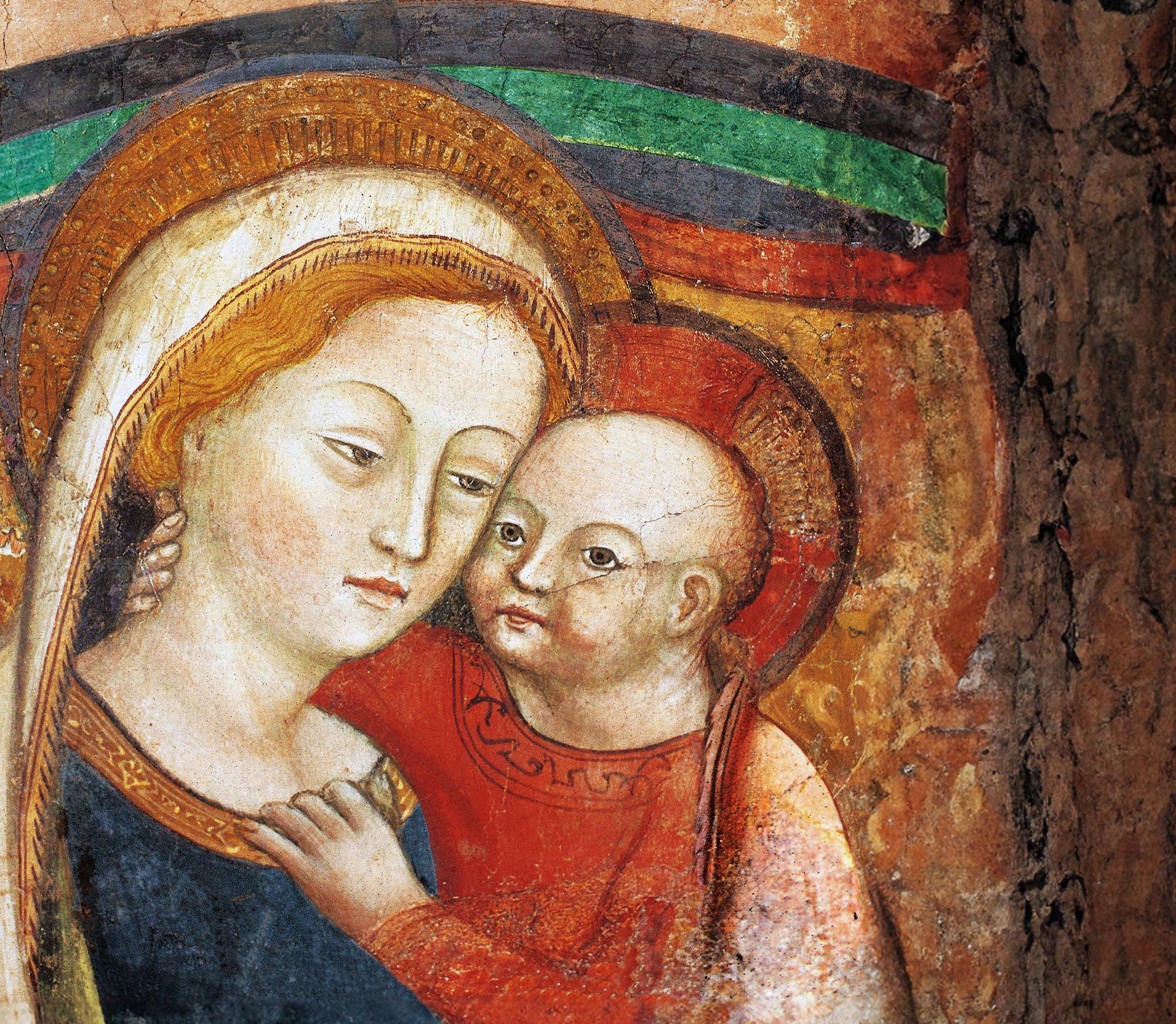
O Mary, Mother of Good Counsel, you are the first and most faithful of the disciples of Jesus. Our Father chose you to present his Son to the world; guide us on the path that leads to him. In this passing world, our hearts are fearful and our judgments uncertain. We come to you for guidance that we may know Jesus, and for confidence that we may put all our trust in him. Instruct us in the way of generous giving that we may share his and your love for all. O Mary, the dwelling place of God’s wisdom, guide us in all we do and set our footsteps on the way of peace. Our Mother of Good Counsel, pray for us.
THE FEAST OF OuR MOTHER OF GOOd COuNSEL IS ApRIL 26
Side Chapel, Upper Shrine a
Augustinian devotion to Our Mother of Good Counsel, which is centered at her Shrine in Genazzano, Italy, is fostered here at Saint Rita Shrine each Monday after the morning and noon Mass. We welcome you to make the beautiful prayer we offer, together with the recitation of Mary’s Litany, your own.
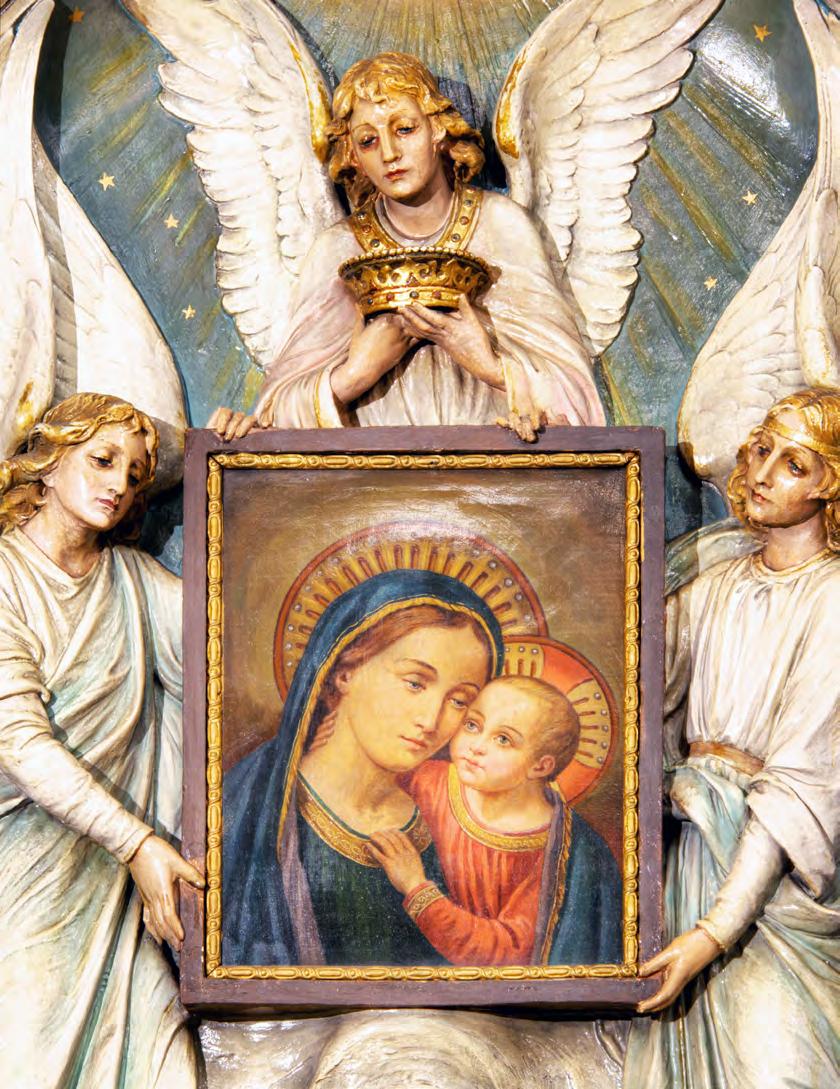 Our Mother of Good Counsel, fresco Augustinian Church in Genazzano, Italy Circa 1417
Our Mother of Good Counsel, fresco Augustinian Church in Genazzano, Italy Circa 1417

roses and a veneration of the relic will take place at all Masses.

NONPROFIT U.S. POSTAGE PAID PHILADELPHIA, PA PERMIT NO. 38 1166 South Broad Street Philadelphia, PA 19146 SaintRitaShrine.org 215-546-8333
n Sunday Monday Tuesday Wednesday Thursday Friday Saturday Saint Rita Solemn Novena to MONDAY, MAY 13, 2024, THROUGH TUESDAY, MAY 21, 2024 12 13 14 15 16 17 18 19 20 21 22 23 24 25 26 27 Mass Times 8:00 a.m. 12:00 p.m. 5:30 p.m. Mass Times 8:00 a.m. 12:00 p.m. 5:30 p.m. Mass Times 8:00 a.m. 12:00 p.m. 5:30 p.m. Mass Times 8:00 a.m. 12:00 p.m. 5:30 p.m. Mass Times 8:00 a.m. 12:00 p.m. 5:30 p.m. Mass Times 8:00 a.m. 12:00 p.m. 5:00 p.m. (Vigil) Mass Times 8:00 a.m. 12:00 p.m. 5:30 p.m. Mass Times 8:00 a.m. 12:00 p.m. 5:30 p.m. The Feast of Saint Rita of Cascia see below Mass Times 8:00 a.m. 12:00 p.m. Mass Times 8:00 a.m. 12:00 p.m. Mass Times 8:00 a.m. 12:00 p.m. 5:00 p.m. (Vigil) Mass Times 10:00 a.m. 12:00 p.m. (Healing Mass) Mass Time 9:00 a.m. Memorial Day Mass Time 10:00 a.m. Solemn Feast of Saint Rita Daily Confession | Monday through Saturday 10:45 a.m. – 11:45 a.m. & 4:00 p.m. – 5:00 p.m. Mass Times: 8:00 a.m. • 10:00 a.m. • 12:00 p.m. 3:00 p.m. • 5:00 p.m. • 7:00 p.m. Confession Times: 9:00 a.m. • 11:00 a.m. • 2:00 p.m. 4:00 p.m. • 6:00 p.m.
blessing of
r o S e S wi LL be aVai L ab L e for purcha S e before each m a SS in front of the S hrine Mass Time 10:00 a.m.
Come See
A












 Shrine of Santa Rita Cascia, Italy
Pope Francis with Paul Koenig
© Vatican Media
Shrine of Santa Rita Cascia, Italy
Pope Francis with Paul Koenig
© Vatican Media



 Saint Augustine by Wladimir Petrichev
Saint Augustine by Wladimir Petrichev



 by S. G. Rudl,
by S. G. Rudl,








 AFr. Matthew John Corcoran, O.S.A.
AFr. Matthew John Corcoran, O.S.A.

 Saint Rita, 1910
Saint Rita, 1910



 Our Mother of Good Counsel, fresco Augustinian Church in Genazzano, Italy Circa 1417
Our Mother of Good Counsel, fresco Augustinian Church in Genazzano, Italy Circa 1417

